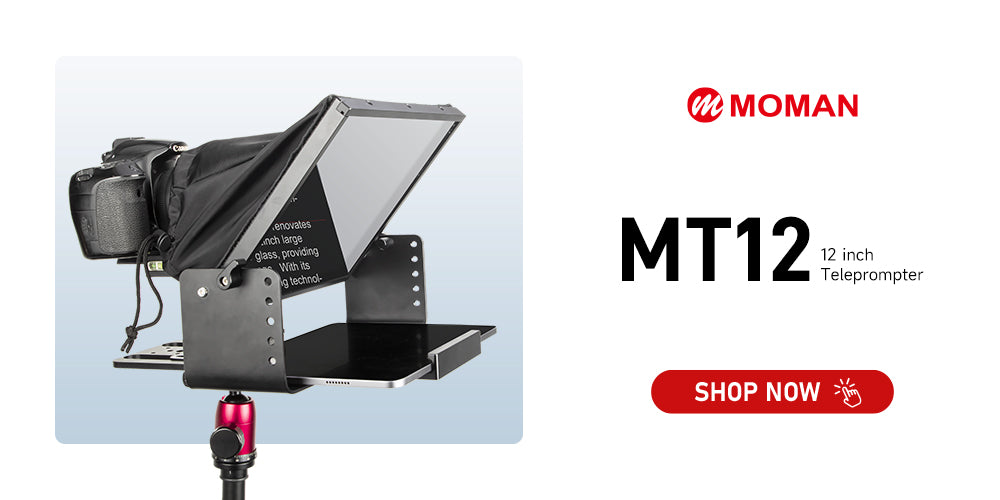A teleprompter is a tool that helps on-camera speakers read scripts without using handheld notes or cue cards. It works by displaying scrolling text on a mirrored glass positioned in front of the camera lens. This setup allows presenters to maintain direct eye contact with the camera while reading their lines, creating a more natural and engaging delivery.
But how to choose a teleprompter for mirrorless camera? There are six key factors to consider. Read on for details.

Teleprompter size: Choose the screen size based on your viewing distance for natural on-camera performance
A teleprompter's dimensions directly impact the script display area and optimal viewing range. While increased size offers advantages, selecting the appropriate dimensions requires careful consideration of several factors. Positioning an oversized teleprompter too close to the speaker can cause noticeable eye and head tracking movements as they follow the scrolling content. This makes it obvious to the audience that they're using a reading aid.
A practical guideline for proper setup involves matching the screen measurement in inches to the distance in feet. For example, a 10-inch display works optimally at 10 feet, while a 15-inch screen performs best at 15 feet away.
Beam splitter glass: Look for a good light transmission-to-reflection ratio to ensure clear and readable text
The beam splitter is the most vital element in a teleprompter, significantly influencing the overall viewing quality. Premium beam splitters often feature a tint-free mirror coating on the reflective side. This helps minimize color distortion and blurring while enhancing image clarity and contrast, resulting in a more lifelike and detailed display.
The back side typically includes an anti-reflective coating. This reduces light loss and minimizes interference, helping to eliminate double images or "ghosting." This coating decreases surface reflectivity and boosts light transmission, ensuring sharper and more accurate visuals.
Beam splitter specs are typically listed as 60/40 or 70/30, indicating the ratio of light transmission to reflection—for example, 60% transmission and 40% reflection, or 70% transmission and 30% reflection.
A 60/40 splitter reflects more light, which enhances text readability, but allows 10% less light to pass through compared to a 70/30 option. This slight loss can be offset by adjusting your camera’s ISO, making the 60/40 beam splitter a popular choice among users.
Compatibility: The teleprompter for mirrorless camera should be compatible with your display device, lens, and tripod load capacity
You’ll need to ensure compatibility in terms of display size, lens type, and mounting options.
Selecting a teleprompter that matches your device’s size is essential for smooth production. Compatibility differs widely between models—some cater to tablets up to 11 inches, while others support larger options like 12.9-inch iPads or Android tablets. Be sure to check that your device fits within the teleprompter’s size limits, which are often capped at around 9.84 by 8.68 inches.
Also, take lens compatibility into account. Certain teleprompters may not perform well with wide-angle lenses and typically need a minimum focal length, often more than 28mm. This is crucial to ensure the image captured is both clear and sharp.
Consider the mounting options as well. Many teleprompters come with universal 15mm LWS rod clamps or standard tripod threads, making them compatible with a variety of camera systems. Some teleprompters are specifically designed for DSLR or mirrorless cameras, while others offer broader compatibility with smartphones and webcams. Taking these aspects into account will help you make a more informed decision, improving your on-camera performance.
Build quality: An aluminum alloy build is ideal for supporting mirrorless camera setups with stability and durability
The build quality affects both durability and stability during filming. For heavier camera setups up to 44 lbs (20 kg), a solid and reliable build ensures the camera teleprompter stays steady. It allows you to concentrate on your presentation without interruptions.
Choose teleprompters crafted from premium materials such as aluminum alloy. This combination of lightweight and durable construction facilitates easy transport and setup, which is essential for videography on the move.
Control options: Look for a teleprompter for mirrorless camera with remote and app controls for smooth, real-time adjustments
For a smooth and professional delivery, your teleprompter should offer adjustable scroll speed and reliable control options. Many modern models feature:
- Bluetooth remotes or foot pedals for hands-free operation, making it easy to manage scripts while presenting.
- Voice-activated scrolling that automatically adjusts speed to match your speaking pace, supporting a more natural flow.
- Customizable text display with adjustable font size, spacing, and mirroring to ensure readability in different lighting setups.
In addition, the teleprompter app plays a key role in your overall experience. Choose software with an intuitive interface that makes script uploads and real-time adjustments simple. Essential features include customizable scroll speed and font settings.
Budget: Decide how much you are willing to spend on it without sacrificing essential features
Teleprompters come in various price ranges, from budget-friendly choices ideal for beginners to premium models designed for professional use. Decide how much you're ready to spend, keeping your budget in mind, but ensure you don't sacrifice essential features. View this purchase as an investment in your professional development and select a prompter that provides the best value for your investment.







